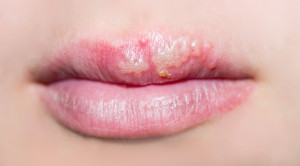Introduction
The characteristics of this viral skin infection (full medical name: herpes simplex) are a painful accumulation of vesicles on top of a reddish patch of skin. Notably, there are two subtypes of herpes simplex virus (HSV-1 and HSV-2). The herpes simplex virus retreats after an eruption on the skin into the ganglion of the sensitive nerve, where it lies dormant and stays for years. To explain, it is thought that periods of stress, exposure to sunlight, other febrile illnesses, excessive sports activities and immune suppression cause a reactivation of HSV-1 and HSV-2.
The 2 Types of Herpes
| Herpes simplex virus, type 1 (HSV-1): involves skin or mucous membranes around face, lips, gums, the lining of the oral cavity, cornea, and nostrils. |
| Herpes simplex virus, type 2 (HSV-2): involves skin around the male and female genitals and the anorectal area in homosexual males. When a pregnant woman has HSV-2 the fetus can get the virus from the birth canal during delivery. This can cause severe systemic herpes simplex infections including encephalitis and aseptic meningitis in the newborn. HSV-2 can also cause a lumbosacral myeloradiculitis, which is associated with bladder retention and severe constipation. |
Signs and Symptoms
Indeed, there is a prodromal period of less than 6 hours. The patient feels an electrical sensation and burning in the infected spot of skin. This is in the skin that is about to break open with blisters.
Clinical course of a herpes infection
In this case a lip sore can already be treated and further deterioration can possibly be prevented. That is to say, at least the extent of the breakout can be kept at bay. A crop of several vesicles appears on a patch of red skin. The size of these clusters of vesicles is between 5 mm and 15 mm (about 1/5 to 1/2 inch). As the vesicles are itchy there is a tendency to scratch them open, which releases the virus and causes a burning sensation. After about 1 to 1 1/2 weeks the vesicles dry up with a yellowish crust. Marketly, the virus retreats into the ganglion of the supplying sensitive skin nerve in the depth of the body. But it only waits for a recurrence in the same spot of skin. This is the dormant phase of the disease.
Herpes infection of genitals, eyes and fingers
For one thing, with lesions in the genital areas of both sexes sex would be very painful. These herpetic lesions occur at the labia of a woman or at the foreskin or shaft of the penis. Certainly, sex is not advisable in order to prevent spread of the disease to the partner. Herpes simplex keratitis is an eye infection with HSV, which starts like conjunctivitis with redness in the eye. There is light sensitivity and there might be a foreign body feeling although no dust particle can be found. An eye specialist must immediately assess this condition to prevent disasters. One of the complications can be a corneal perforation from herpes simplex keratitis.
Other herpes virus infections
Health care workers who examine patients can get a herpetic infection of the fingertips, called “herpetic whitlow“. The area from the last joint of the finger to the fingertip is extremely painful and it shows swelling and redness. This is due to infiltration of herpes simplex into this tissue (see picture 3 below). The virus gained access through mini abrasions or breaks in the nail folds. Here are some pictures of herpes infections (use the back arrow in your left upper screen to return to this page):
Pictures of herpes infections in various locations:
3: herpes around toe nail fold
Diagnosis and prognosis
There are a variety of methods to diagnose HSV directly. The most specific is a genetic test using a polymerase chain reaction. Most cases of HSV are self limiting, might recur a few times at intervals of several months or years, but eventually seem to settle down with increasing antibodies against HSV. However, a small percentage of patients experience continuously recurrent outbreaks every few weeks of labial or genital lesions. For these patients antiviral coverage for a longer period of time would be reasonable. AIDS patients who have a weakness of the immune system require antiviral HSV therapy continuously.
Herpes treatment
For serious conditions such as HSV encephalitis, meningitis or systemic HSV disease with pneumonia and hepatitis the physician starts swift intravenous therapy with acyclovir or other antiviral antibiotics. Later when the patient is stable the physician switches the patient to oral medication. More local disease in either the genital area or the face requires treatment with local applications except for the cases with more frequent recurrences. In these patients the physician administers oral antiviral HSV therapy for a period of time such as 6 or 12 months.
Treatment of herpes simplex keratitis
Herpes simplex keratitis is a potentially dangerous eye infection where the cornea could perforate, if not treated properly. An eye specialist should supervise this condition. Trifluridine (brand name: Viroptic ophthalmic solution) is given several times a day. At times the eye-specialist will decide to also treat with oral acyclovir at the same time. Topical corticosteroids are contraindicated (which means forbidden) as this could lead to corneal perforation. Any bacterial superinfection on skin of the genitals or around the face is treated with topical ointment (bacitracin / neomycin). At times oral antibiotics are necessary, if impetigo follows the initial HSV infection.
References
1.The Merck Manual, 7th edition, by M. H. Beers et al., Whitehouse Station, N.J., 1999. Chapter 265.
2.James Chin et al., Editors: Control of Communicable Diseases Manual, 17th edition, 2000, American Public Health Association
3.The Merck Manual, 7th edition, by M. H. Beers et al., Whitehouse Station, N.J., 1999. Chapter 112.
4. The Merck Manual, 7th edition, by M. H. Beers et al., Whitehouse Station, N.J., 1999. Chapter 115.
5. The Merck Manual, 7th edition, by M. H. Beers et al., Whitehouse Station, N.J., 1999. Chapter 113.







